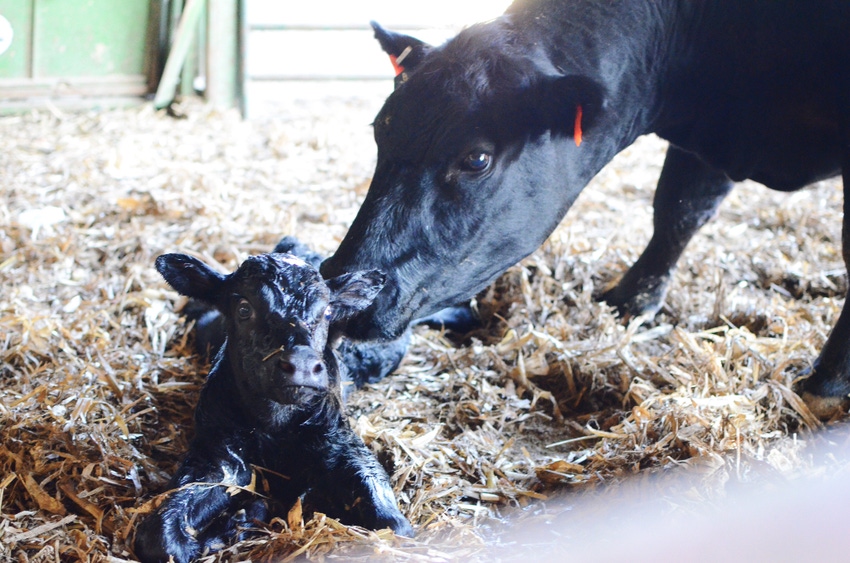Pulling a calf? Here’s the best way
If a heifer or cow needs assistance calving, helping her deliver the way nature intended can lead to more success.
January 3, 2019

One of my passions in veterinary medicine, besides beef production medicine, is teaching veterinarians and producers an easier way to deliver calves. I always start off my dystocia talks with the numbers 15 and 3. If you have to assist more than 15% of your heifers and 3% of your adult cows, you have a problem that needs attention and it’s most likely your genetics.
That being said, anyone who calves out heifers will likely have to assist one every so often. The Utrecht technique that I learned about 30 years ago from Bob Mortimer at Colorado State University is the easiest way to deliver a calf, in my opinion. It’s easy on the human, the cow and the calf.
The keys to success are:
Start with the cow standing, ideally in a chute and do a vaginal exam. If the calf is coming in the correct position, go to the next step which is dilation. If the calf is in an abnormal position, call your herd health veterinarian for assistance.
Now the calf is in correct position. Put both lubed and gloved arms into the birth canal, interlock your fingers and expand your forearms laterally to stretch the tissue. This prevents tearing the delicate tissue of the birth canal. Do this for 1-3 minutes.
Put chains on the front legs with a half hitch above the fetlock and one between the fetlock and hoof as you normally do.
Take a long rope and use the double half hitch method to place the rope around the cow (see picture and video). Halter the cow and as you slowly (ideally) back the cow out of the chute. Tie the lead from the halter low at the back of the chute. Never pull a calf in the chute as the cow could go down and then you are in real trouble.
I have used this technique on hundreds of heifers and cows for over 25 years. My only trouble is with aggressive females. This is where a halter with a long lead rope is key. As she backs out of the chute, have the end of the rope halter already wrapped around the bottom of the chute. Take up the slack quickly as she backs and tie her off. I have used tranquilizer on very rare instances with extremely fractious females.
Put hooks on the chain and start to apply pressure to the chains at the same time you have your assistant pull firmly on the end of the rope. Apply steady and increasing pressure to the rope until the cows lays down.
Keep steady pressure on the rope or tie it to a solid object. Wait about 5 seconds and grasp the part of the rope parallel to the cow’s back and gently pull so that she lays flat out on her side.
When the cow is down on her side, she is in her natural position to deliver a calf. The cow pushes much harder and her pelvis is able to tilt slightly to allow the pelvic opening to functionally increase in size, making the calf come out more easily.
Pull calf with hooks or use calf jack. The key is to go slowly and only apply pressure when the cow pushes. When she rests, you rest. When the chest of the calf is delivered, stop pulling and take a break. If you wait about 30 seconds, the cow will give a slight push and the pelvis of the calf will twist about 90°, which lines the widest part of the calf’s pelvis with the widest part of the cow’s pelvis. Give another pull and the calf should pop right out. The only time I do not pull slowly is on a backwards calf. Once the hips come through the pelvis, I’m pulling hard and quickly.
Let’s hear from some veterinarians and producers who use the Utrecht technique.
Kayla Clark, DVM
Sterner Veterinary Clinic
Ionia, Mich.
The first time I used the Utrecht technique was on a first-calf heifer trying to deliver a large calf. The calf was positioned correctly but due to its size and the anatomy of the heifer’s pelvis, little progress was being made.
At first, I tried pulling the calf up and over the pelvis into the birth canal while the heifer was standing. After little progress, I decided to try the Utrecht technique. Once the heifer was positioned on her side, I applied additional lube and attached the calf jack. I found that not only was progress being made but also the heifer increased her effort during contractions. After a short time, the calf was delivered; heifer stood and was found to have no tears in the birth canal.
The extra space, improved pelvic angle, and not having to pull a calf up into the pelvis have made my dystocias more manageable and with better outcomes.
Christine Fortin, DVM
Center Hill Veterinary Clinic, SC
Darlington, Wisc.
I have been practicing as a rural Wisconsin veterinarian for 29 years. I first heard Dr. Hilton speak at a continuing education meeting five years ago. His video demonstration and explanation of the Utrecht method of delivering calves challenged my own thinking and technique in the application of veterinary assistance on tough calving calls.
Dr. Hilton reminded his audience that Mother Nature sends a cow to a quiet, secluded location, where she lays down on her side, legs extended, and unloads her weight from her hip joints, thereby allowing the pelvis more freedom to tilt. When all is well, the labored contractions, which are stronger when recumbent, will result in delivery of a live, healthy calf. Dr. Hilton challenged us to think about the advantages of trying to mimic Mother Nature when things aren’t going so well.
Throughout my career I have witnessed many cases of incomplete cervical dilation, obturator nerve paralysis, uterine artery hemorrhage, vaginal and cervical trauma, uterine prolapse, and weak or downer cows post-calving. All too often, baby calves can suffer from fetal stress, oxygen deprivation, dislocated hips or fractured limbs, and overall poor calf viability and performance.
As a veterinarian, I know that a multitude of factors can play a role in post-calving complications. However, if improved techniques exist, didn’t I have an obligation to my patient, my client, and myself to do better? We invested more time dilating, we laid cows down, we slowed down, and we taught clients when to call for help. The Utrecht technique has significantly reduced post-calving complications and increased calf viability, especially in cases of fetal pelvic disproportion.
I am reminded of the quote “Do the best you can until you know better, then when you know better, do better!”
Nora McLaughlin, DVM
Cashton Veterinary Clinic
Viroqua, WI
I have used the Utrecht method many times since learning about it and it has been a great experience. As a relatively short female practitioner, I sometimes struggle with having the upper body strength and correct angles to efficiently assist with a calving. Having a cow down and being able to use my legs more gives me more leverage and I've been able to use the calf jack less frequently.
I also find that resting when the cow rests allows me to be more effective (and stronger) when I pull in synchronization with her. Clients have commented on how much calmer the process appears when I use this method and the obvious benefit is the ability to get a large calf out with less trauma.
Justin Wedig, Darlington, Wisc.
Last spring, prior to when our calving season began, we had been having multiple discussions with our local vets to discuss how we could have fewer calving troubles. We raise highly competitive show steers and heifers on our operation so switching our genetics to more calving ease is not an option for us. Dr. Fortin had heard Dr. Hilton speak at a conference about a different method to pull calves. She got in contact with him. We had a very insightful informative meeting between all of us and decided to try this method.
We were very skeptical going into it, but we thought we would try it. It took a day or two to get our facilities set up to make this feasible and safe for everyone involved. Once we got it figured out, we were able to lay the cows down without much trouble at all and it proved to be very beneficial.
We noticed the cows pushed harder than they ever would while standing. The calf was able to naturally rotate its hips as it came through the birth canal as we pulled, which seemed to make a big difference. We were able to lower our mortality rate and had a lesser incidence of vaginal tearing when delivering large calves.
We also noticed the calves got up and nursed much quicker after delivery. This was due to less stress during the delivery. It might take some extra time and manpower to deliver calves via the Utrecht method, but we fully believe it helped us in being able to have more live calves and calves with much more vigor at the end of the day.
You can go to my website www.mwbeefcattle.com and go to Educational Tools and then Videos. I show how to manually dilate the birth canal, use a long rope to cast (lay down) the cow and how to use the fetal extractor (calf jack) to deliver the calf.
Hilton, DVM, PAS, DABVP (beef cattle practice), Clinical Professor Emeritus, Purdue University College of Veterinary Medicine; Senior Technical Veterinary Consultant, Elanco Animal Health.
About the Author(s)
You May Also Like




.png?width=300&auto=webp&quality=80&disable=upscale)
